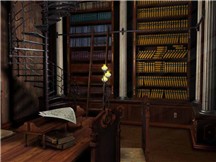Sherlock Holmes: Mystery of the Mummy
(first
released in Europe as Curse of the Mummy)
Story
You are Sherlock Holmes.
You are urgently beckoned by a distant cousin, the lovely Elisabeth
Montcalfe, to find her father Lord Montcalfe, who is a famous
archeologist specializing in ancient Egyptology. You arrive at the
Montcalfe mansion, which also serves as a private museum, sans Doctor
Watson. Oddly enough, Watson does not accompany you on this particular
investigation as he's off on seemingly more urgent business with Mrs.
Watson.
Upon your arrival at the
mansion you are greeted by a rather stunning array of ancient Egyptian
artifacts and, later, a mind-bending miasma of puzzles, timed and not so
timed, and a virtual maze of hidden chambers, alcoves, niches,
compartments and conundrums, along with other secrets real and
imagined.
The entire game is played
within the confines of the mansion/museum. It becomes obvious early on
that the disappearance of Lord Montcalfe is linked to his harbored
illusion of having released a dreaded mummy's curse. This apparently
occurred during the course of acquiring the ill-gotten mummified remains
of an ancient Egyptian royal. Our missing host, delusional with the
effects of the drug laudanum and his obsession with retaining his
ancient treasures, has planted lethal booby traps all over the mansion.
So, valiant Sherlock, beware as you search for Montcalfe, unravel the
mystery and finally meet with good old Watson at journey's end!
Graphics/Music
The music provided in the
game is appropriate and ties in well with the production and the action
taking place. I found it to be pleasant and neither repetitive or
distracting. The graphics are well done, but also tend to be quite dark
at times. It was necessary to lighten my monitor in some areas; a
particular wine cellar and storage room.
Game Play
Sherlock Holmes: Mystery of
the Mummy is a first person, point and click adventure that proudly
sports fluid 360 degree navigation, including full vertical. The
navigation is intuitive and highly responsive. No complaints here.
The game was developed in
five distinct levels. There is no danger of missing something as you
progress through the levels. You will not be able to proceed to the next
higher level if a missing piece is not revealed, or a puzzle is not
unraveled.
The cursor ordinarily
displays an ornate Sherlock type pipe for general navigation. A
magnifying glass (appropriately enough) is displayed for access to close
ups, and a crescent wrench cursor appears for potential interactivity
with other items. The museum is replete with notes, letters, and
documents of all kinds that after reading, will be stored in your
"letters" inventory, which is separate from other accumulated hardware
and paraphernalia. Mummy provides a veritable inventory jubilee.
The story is logically
moved along by frequent text and narrative comments from Sherlock and
cutscenes interspersed at frequent intervals. Although the cutscenes
provide clues during the interaction between characters, there is no
text option provided here.
There are several extended
timed sequences in the later stages of the game, but I found this to be
of no concern whatsoever. If you save often and move at a good steady
pace, you should have no problem. Although you can "die" often in the
game there are no action sequences. The timed sequences provide
sufficient quantities of "chill factor."
Puzzles
This game is absolutely
loaded with puzzles! Solving a conundrum, where you are rewarded with
entry to another section of the museum, or by gaining another necessary
inventory item, is presented almost literally every time you turn
around. In the beginning of the game, the puzzles are quite simple and
the logical progression of the game is accomplished easily and
obviously, in finding proper solutions. However, as the game develops,
the puzzles become more difficult, often requiring multiple, seemingly
unrelated objects from separate areas to find the answer. The two most
difficult puzzles in the game involve finding the single correct
sequence to open a stoned-in doorway and a timed sequence involving a
complex Japanese (Conceptis/Gridder) pictorial puzzle, which changes
from game to game. Both of these engaging and challenging puzzles
required significant quantities of time to solve along with some outside
help from my friends to find the solution.
Pros and
Cons
Mystery of the Mummy
provides a good solid mystery story, though it does not compare with the
intricacy of the comprehensive prequels; particularly The Rose Tattoo.
However, and as some critics have attested, Tattoo may just have offered
too much story for some, as well as being epic in length.
Mummy's production design
is appropriate and very well done, in keeping with the Victorian era of
gas lamps, Persian carpets and heavy tapestries. Being of
claustrophobic persuasion, this author would have enjoyed even a brief
mystical trip (laudanum perhaps) to Egypt's open plains, or maybe just a
short exploratory jaunt around the mansion's garden during daylight.
Sherlock addresses his
charter during the course of the game with his usual objective point of
view, leaving little room for emotional involvement with the deeds or
destiny of this infamous sleuth, or the other characters in the game.
Sherlock is cool, calm and collected the entire time. Voice acting for
Sherlock, provided expertly by John Bell, adds cryptic narrative as you
progress through the game.
There are only six save
game slots. I found this a little disappointing in a game that seemingly
welcomes other technological attributes. Additionally, the game
automatically inserts the time, day and date to record your save games.
Although a popular trend, I much prefer entering a personalized title
for each of my save games.
Mystery of the Mummy plays
entirely on a single disk. The game has excellent technical integrity.
It plays as smooth as silk. I had no technical glitches or bugs
whatsoever. This fact is duly noted and was highly appreciated!
Bottom
line: I recommend it!
My
System:
512 MB DDR PC 2100 DDR
2A GHz P4 Processor
40X CD ROM
Windows XP (Home)
copyright © 2002
GameBoomers

